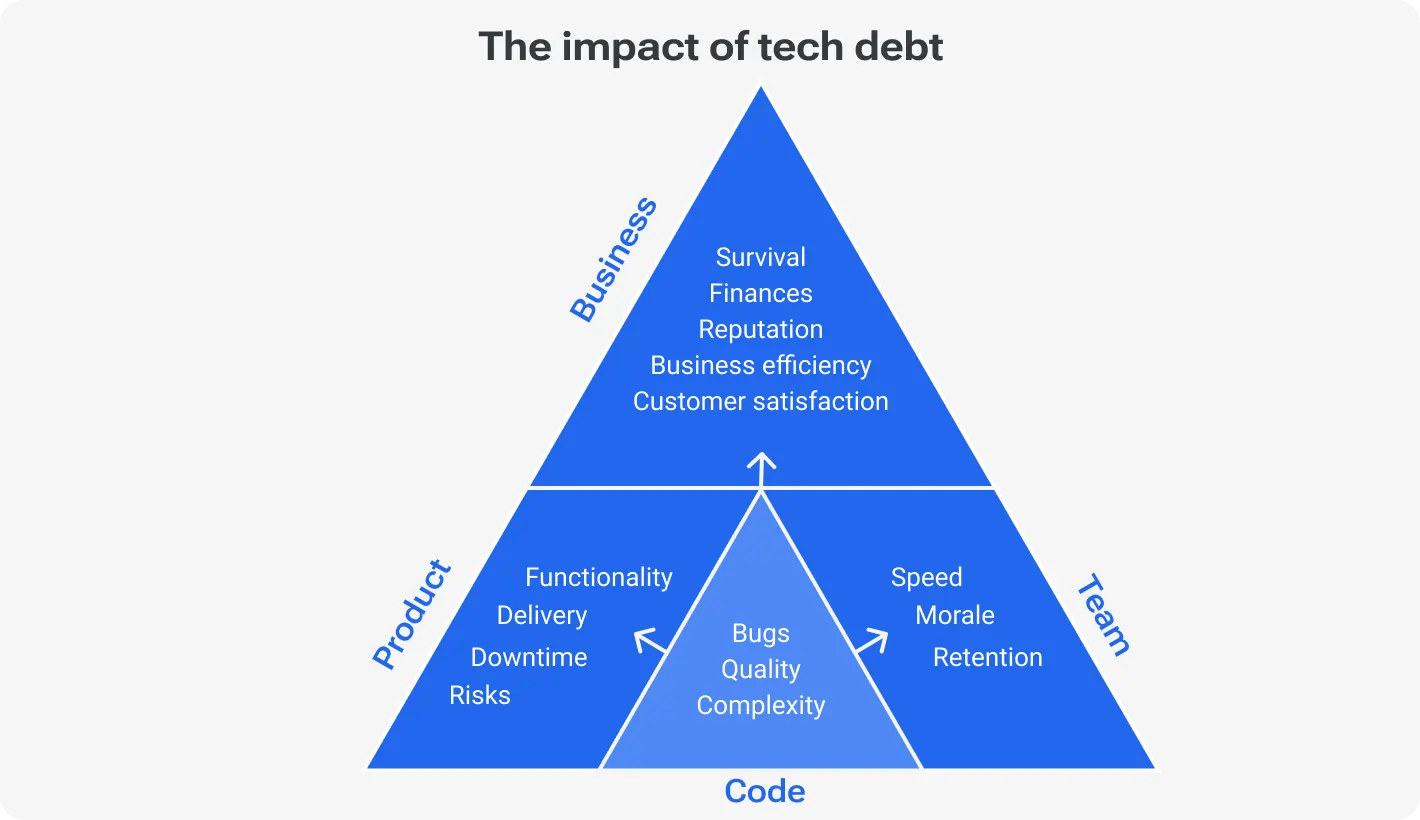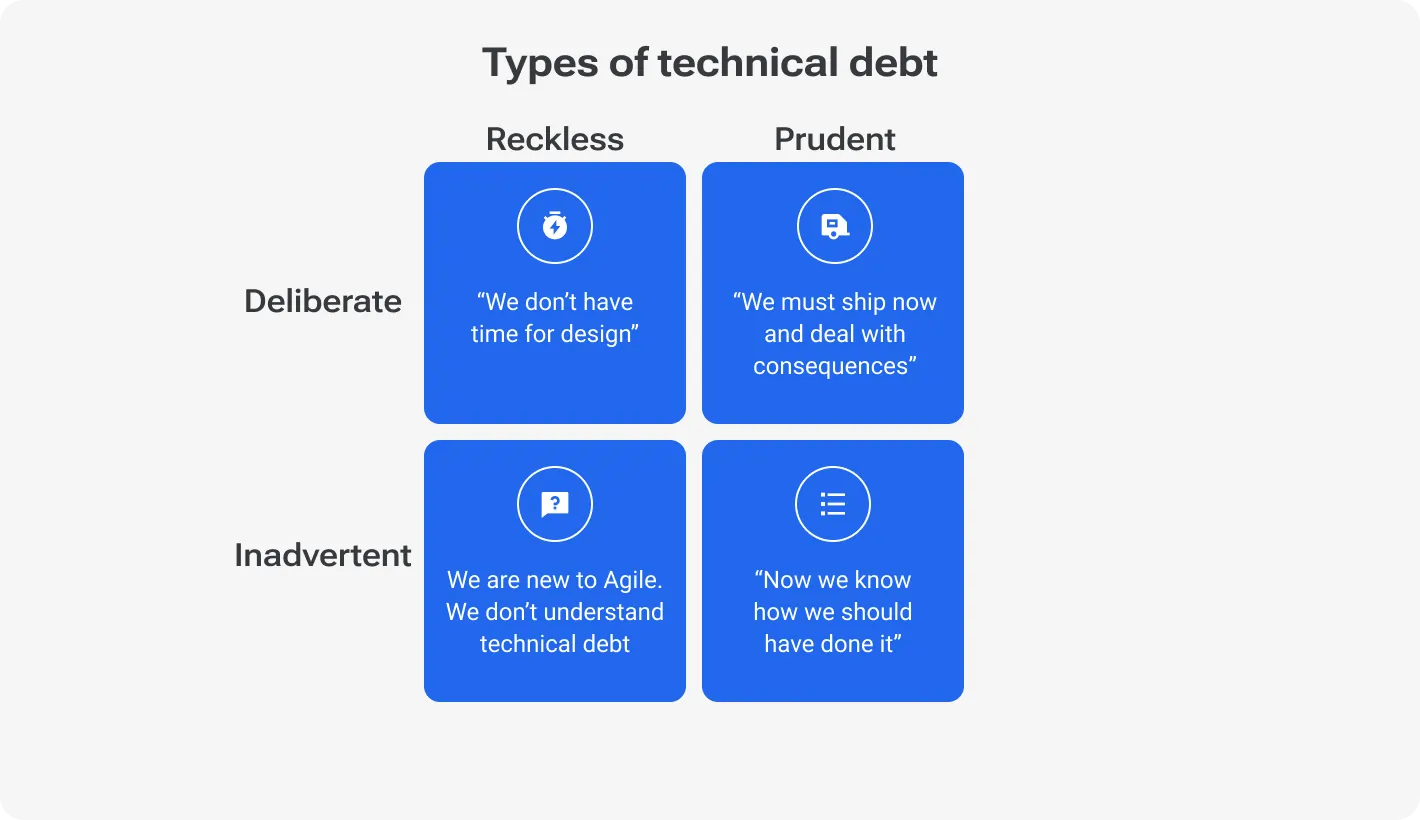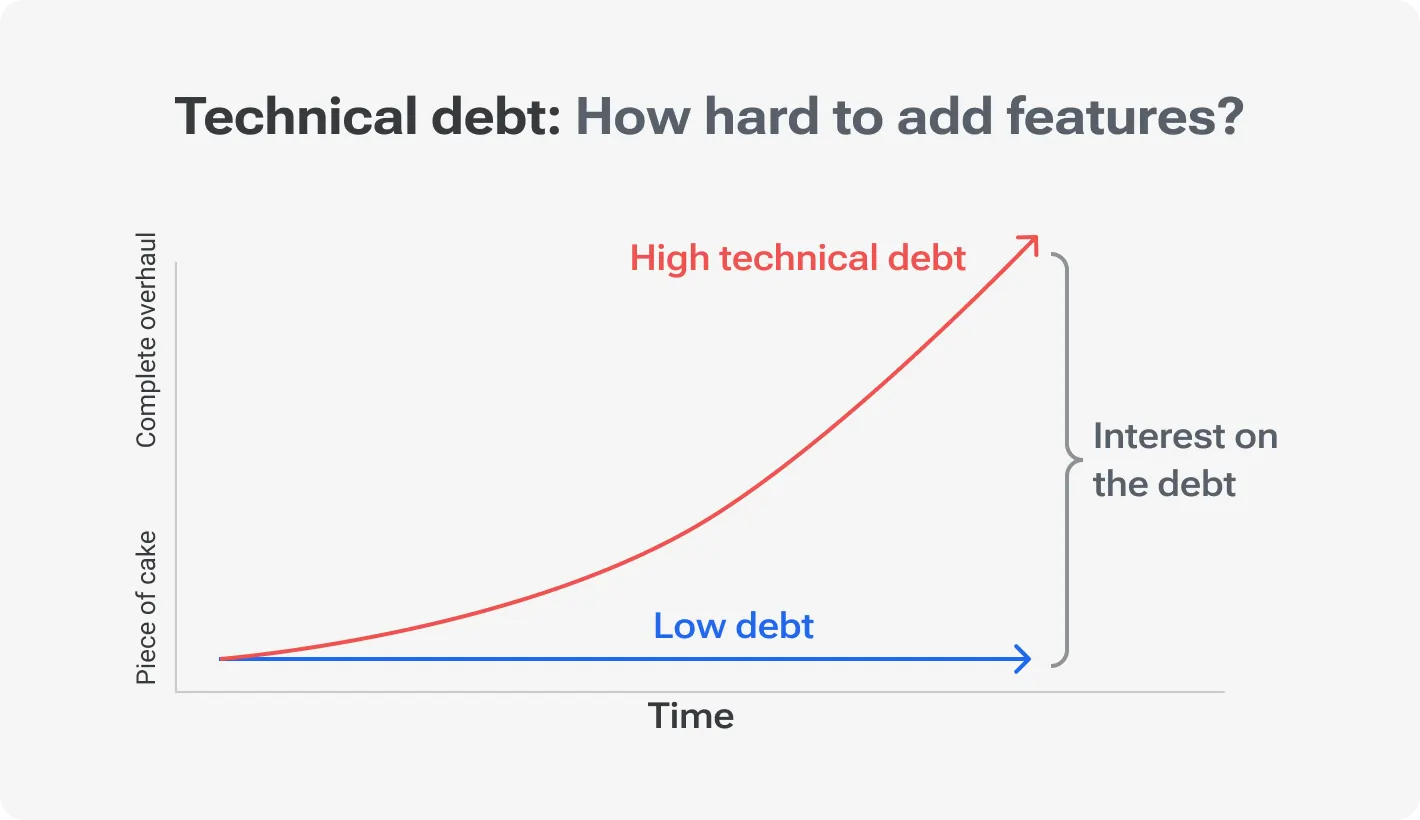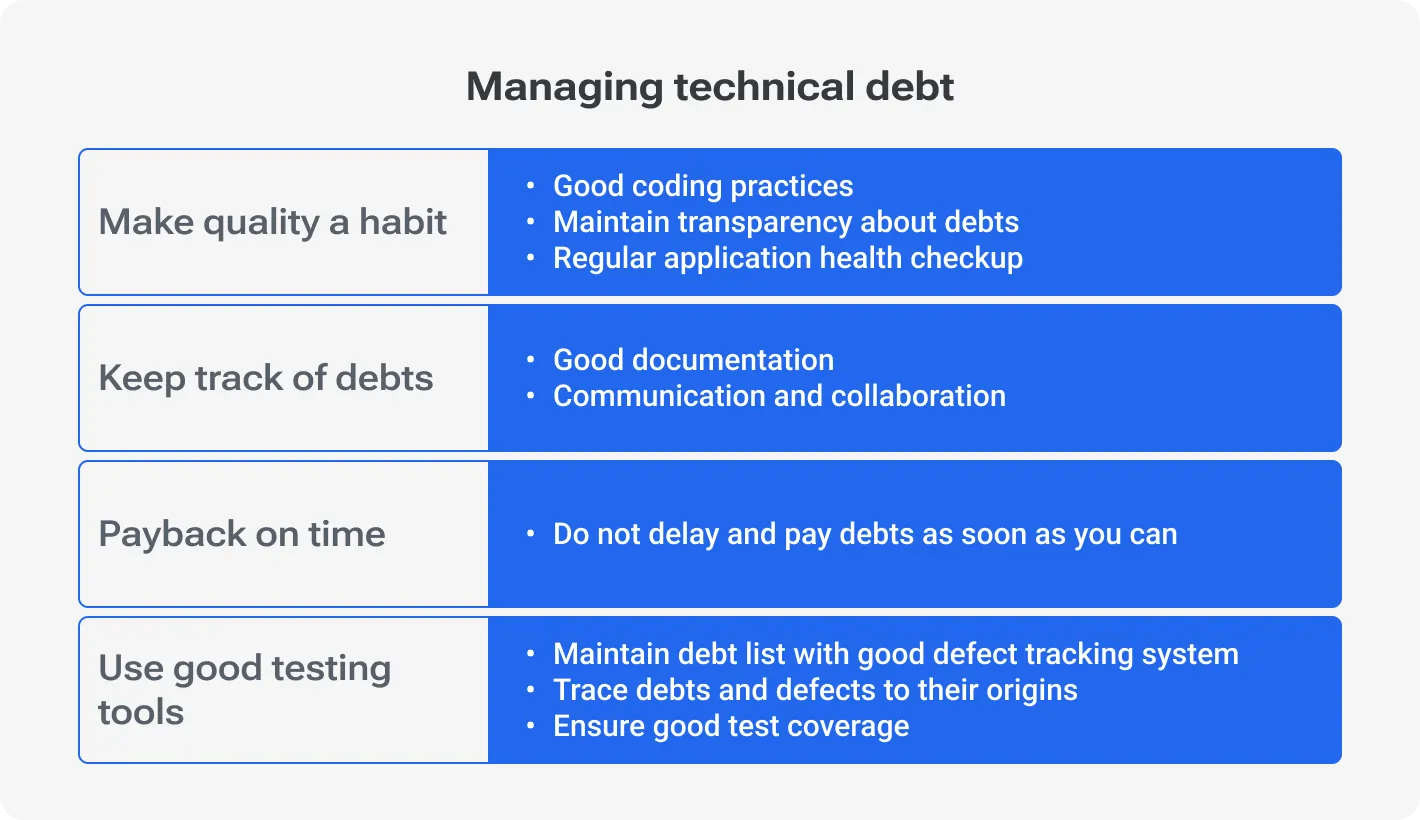Technical debt is a common issue IT companies face. This is particularly prevalent in agile methodologies, where the focus on rapid delivery can sometimes lead to shortcuts that accumulate over time. In fact, around 70% of organizations acknowledge that technical debt significantly hinders their ability to evolve and stay competitive.
How exactly does it affect the workflow and final results, budget, and deadlines? How to deal with it correctly? This article reveals the unexpected truth about technical debt and effective ways to manage it.
The concept and impact of technical debt explained
Many companies face this problem and would like to know how to deal with it effectively. To understand how to cope with it, let's first look at:
what types of it there are.
Technical debt: The definition
These are the consequences that result from choosing the quickest and easiest way to accomplish a task instead of the best and most optimal way. For example, it could be writing code that is quick to create but hard to maintain afterward. This then leads to the need for developers’ additional work, and, consequently, to additional expenses on the part of the company.
The concept of "technical debt" was introduced because the phenomenon is somewhat similar to credit. By preferring the fastest solutions to the best ones, a company sacrifices time and costs to support and fix these less-than-optimal solutions in the future.
And if technical debt is ignored, it can lead to the accumulation of "interest". In the future, it becomes more and more difficult to make necessary improvements to the product. To avoid this, it is crucial to make timely efforts to manage this phenomenon.
If tech debt is so bad and leads to negative consequences, why do businesses allow it to happen? Sometimes choosing this solution is necessary to get the product to release faster, overcoming competitors. This significant benefit is sometimes worth all the additional spending that arises over time.
Real-life precedents of tech debt
To make it clear what it is, let's look at some real-life examples. Here are a few stories of how technical debt appeared and what it led to.
The transition between centuries
One of the most famous and large-scale cases of technical debt occurred in 2000. Most IT companies in the 20th century, to save memory, used two digits instead of four to denote the year, for example, 78 instead of 1978. However, code written this way continued to run longer than intended.
And as the year 2000 approached, many companies realized that the switch to a 4-digit year designation could completely break the date calculation. This led to the need to urgently correct all year denotations on a massive scale. For this, organizations spent a staggering sum of about $100 billion in total.
Instagram database crisis
Instagram was originally launched in 2010 on one single server. After running for only a few hours, due to a surge in traffic, the server became so overloaded that the app almost crashed completely.
This resulted in the application having to be urgently migrated to another infrastructure overnight in order to scale. This was a lesson for the creators, and they are now taking steps in advance to expand capacity in line with projected traffic growth.
Empower your IT team to focus on innovation and growth by outsourcing your technical debt management
What types of technical debt exist?
Depending on what aspects of the workflow this phenomenon affects, it comes in several types. You will find a quick overview of each kind in the table below.
Tech debt types
Sometimes deadlines are so tight that developers have to write code that is not of the highest possible quality. There may be too large classes and methods or repetitions in it. It may also be poorly structured and may not contain comments that are necessary for quick and easy understanding of it when it is needed to make changes. All these issues that code debt may include often result in complications of code maintenance and improvements.
This type includes all the flaws that relate to the environment. This can be insufficient server capacity, non-ideal network configuration, poor infrastructure stability and security, and so on.
This kind stands for various defects related to the interface of the product. It may include an ill-conceived interface or outdated design. It often occurs when a company devotes more time and attention to back-end development than to the front-end. No one disputes that the correct operation of all application functions is essential. But the design is no less important, as it directly influences the customer experience and satisfaction rate.
In some cases, companies are in such a hurry to get a product into release that they neglect the testing process. This can lead to a large number of bugs that will still need to be fixed in the future. It also increases the risk of errors and failures, which can have a negative impact on customer experience.
This type occurs because many teams do not spend much time on the application architecture building phase. However, the quality and correctness of the architecture can determine the ability to scale, improve, and change the product in the future. Fixing errors of this type can be very expensive and time-consuming.
Many organizations do not focus on creating, developing, and updating documentation at all. Some even consider this process a waste of time. However, it is not. Inadequate, poorly structured, or outdated documentation can lead to great difficulties in the adaptation of new employees and misunderstandings between team members. All this often results in quality problems.
The peculiarities of technical debt in agile development
Flexible development methodologies, such as Scrum and Kanban, provide for the fastest possible delivery and release of the product, thus reducing time-to-market. In addition, these schemes of work involve development in many iterations within sprints (limited periods of time in which to accomplish certain tasks). At each such stage, some deficiencies that lead to tech debt may arise. Examples of such flaws are:
too massive, incomprehensibly written code;
lack of valuable comments in the code;
repetitive code sections, etc.
If a company makes no attempt to deal with technical debt for a long time, its accumulation can lead to a decline in product quality with each subsequent iteration. The growth of this phenomenon can also provoke timing problems. With each next sprint, it may become more difficult to add new features due to the poor quality or structure of the existing code.
Therefore, it is necessary to constantly manage technical debt in order to keep the speed of work high and not let the quality drop. Agile development methodologies provide the opportunity for this. For example, Scrum involves retrospective evaluations. As part of conducting them, it is possible to identify and eliminate problems related to technical debt.
Surprising truths and unexpected facts about technical debt
Many businesses do not give due importance to this phenomenon. Others are prejudiced against it: they think it can be accumulated indefinitely without significant consequences, or, on the contrary, they consider it an absolute evil and try to avoid it as much as possible. Further in this article, we will reveal the unexpected truth about technical debt, which will allow you to look at it from different angles.
It can be strategically advantageous
Many people perceive this debt as totally undesirable. However, sometimes it can be absolutely reasonable. Sometimes getting to market as early as possible is far more prioritized than the subsequent time and money expenditures. This is when organizations deliberately choose quicker solutions instead of the highest quality ones.
The main thing when choosing such a strategy is to be cautious, to plan trade-offs properly, and to assess risks correctly. For example, before making such a decision, it is worth making the following:
Consider whether it's worth it and whether speed is so important to you at the moment.
Warn employees that this is a temporary solution.
Think in advance about how you will "pay off" this debt in the future;
How much time and budget you will need to manage this phenomenon in the future.
Companies don't always notice it
Organizations don't always realize they have a technical debt. Sometimes when choosing the fastest solutions companies may not notice that they are losing in quality and further flexibility. Failure to realize that tech debt exists and needs to be managed can lead to multiple problems, such as:
decreasing of team productivity;
difficulties in further support of the product;
barriers to further improvements.
It may incur ongoing additional costs with “interest”
Correcting the compromises in quality resulting from speed prioritization requires monetary investment. According to the McKinsey study, most companies spend 10-20% of their IT budget on "paying off" tech debt.
If not managed for a long time, problems can pile up like a snowball. In this case, technical debt generates "interest" just like a real money loan. For example, according to the same McKinsey survey, 60% of companies report that their tech debt has increased over the past 3 years.
How to measure technical debt: 8 top metrics
It can affect the culture within the company
The accumulation of technical debt can lead to a decrease in employee motivation, as they may be dissatisfied with the quality of their work. In addition, revisions and improvements may become more and more difficult to accomplish because of this phenomenon. Therefore, productivity may also be reduced. The level of interaction between colleagues may also decrease: each may blame the other for problems and difficulties that arise due to tech debt.
In agile methodologies, the accumulation of technical debt issues can make it increasingly difficult to do the required cluster of tasks in the allotted time with each sprint. This can lead to employee burnout and undermine team spirit.
It can influence the personnel situation in the organization
The IT field, despite being quite promising, has one of the highest turnover rates across all industries. On average, this rate is 13.2%. And tech debt can only raise it even more.
First, developers, who are constantly forced to choose the fastest ways of solving problems instead of the most qualitative ones, may not feel full professional fulfillment at work. In addition, those engineers who constantly face stumbling blocks to task completion due to technical debt may face burnout. All of this leads to the high risk that employees may seek more comfortable jobs.
Moreover, technical debt can affect the onboarding process of new employees. This process may be prolonged, as new developers may find it difficult to understand the code that has some problems and peculiarities caused by this phenomenon. It will also take time for them to figure out how to fix the problems associated with tech debt.
In order to retain employees, reduce turnover, and shorten new developer adaptation time, it is necessary to:
take measures to manage technical debt;
fix problems related to it in time, preventing the snowball effect;
take actions to increase employee motivation.
It can lead to large time spending
In cases of neglected technical debt, developers may waste up to 42% of their work time on issues related to it. Think about it, that's almost half of engineers’ working time! Such a large time expenditure caused by this phenomenon can lead to such undesirable consequences as:
extra costs associated with paying for these wasted work hours;
employee burnout and decreased motivation.
If you do everything possible to reduce this rate, you can almost double your productivity and avoid other troubles.
It can hinder digital transformation
Most companies are interested in improving and growing their business, so they undertake digital transformation. It helps to increase productivity, increase customization, increase sales, and achieve multiple other positive effects. However, technical debt can be a stumbling block to implementing improvements. Especially if this phenomenon resulted in the use of legacy or inflexible technologies.
This phenomenon can lead to additional time and cost in making changes. Therefore, digital transformation can become more time-consuming and expensive than you originally thought. Therefore, if you are planning a digital transformation, take care of minimizing the problems associated with the debt in advance.
It can have an impact on the recovery process
Downtime costs for large organizations can reach $9000 per minute and for the industries associated with high risks and liability, such as fintech and healthcare, even more than $80 thousand per minute.
To avoid such high losses, you need to do your best to shorten the time for recovery. However, technical debt may, on the contrary, lengthen it. This phenomenon is often associated with some compromises in code quality. Because of them, it can be quite difficult to restore its operation. To shorten the recovery time, fix tech debt issues timely.
Managing technical debt strategies: Useful recommendations and best practices
Technical debt impact on the company is very significant. It affects all processes: from development, updates, and recovery to recruiting and HR management. Therefore, it is crucial to find appropriate ways to manage this phenomenon. Further in this article, we will look at some best practices to do this.
Prevent it
The famous physician Hippocrates said that prevention of the disease is preferable to cure. And this wisdom can be applied not only to medicine but also to IT. It is better to prevent problems related to technical debt than to spend time and money on fixing them.
So think very carefully before resorting to a strategy where you choose the fastest solutions over the best ones. Consider the following:
What benefits you will get out of it.
Whether it will be beneficial to you in the long run.
How you will "pay off" this debt.
Identify it timely
It's not always the case that companies get involved in tech debt consciously. Sometimes organizations are not aware of this problem and the seriousness of it. If problems are not identified timely, they will accumulate like a snowball, leading to more and more difficulties.
Therefore, it is important to conduct regular audits for technical debt. Within agile methodologies, it's better to do this before each sprint.
Document the issues
Creating a document with all the problems described in detail will help to:
Develop a clear strategy for solving the issues.
Improve the effectiveness of employees who troubleshoot these problems.
Make the adaptation of new employees easier, because, having familiarized themselves with the document, they will be aware of possible difficulties.
Get your priorities right
Make a plan to solve the problems. Fix the ones that lead to the most unfavorable results first, as well as those that could lead to new problems. Plan exactly when you will fix the problems.
Within agile methodologies, you can allocate a certain amount of time for technical debt management during each sprint. It is also possible to have specific individual sprints to deal with this phenomenon.
Conduct refactoring and make improvements
Refactoring is the process of improving the code, its structure, and readability without changing its functionality. This is one of the most effective strategies for coping with technical debt. Improved code lends itself better to updates and improvements in the future, which gives the company more opportunities for further development.
Ensure effective communication and collaboration within the company
Effective communication and cooperation are great helpers in overcoming technical debt. First, it is necessary to properly communicate the importance of solving this problem to stakeholders. In doing so, focus not on detailing the problems with code, design, or other aspects, but on their consequences and how they affect the overall atmosphere in the company and the results of organization functioning. In addition, do whatever it takes to bring the team together. Collective fixing of the issues will have a better effect.
Outsource the problem-solving process
Sometimes the difficulties associated with technical debt are so severe that internal staff cannot handle them on their own. Or they may not have enough time to do this. In such cases, an outsourcing company will come to the rescue.
If you turn to an external IT team, you'll get experienced professionals who will solve your problems shortly, at a reasonable price. Additionally, your employees will be free from having to fix these issues, and therefore free for other more important tasks.
Long-term positive effects of managing technical debt
By “paying off” technical debt, you are investing in the future of your company. Managing this problem will help you achieve the following positive results.
Raising the quality of products
Managing this phenomenon helps to make the code better, more responsive to edits and updates, and easier to recover in case of force majeure. Besides, fixing technical debt helps to reduce security issues.
And by eliminating such a type of this phenomenon as design debt, you can improve user experience and raise the level of customer satisfaction. This will help boost sales and increase client loyalty.
Boosting engineers’ productivity
The research conducted in New York has shown that engineers on average waste 23% of their total work time due to technical debt. This is more than one working day each week! To avoid such a huge waste of time and make the workflow more productive, companies use software development best practices and effective methods of managing technical debt.
Strategic technical debt management: Should we aim at zero technical debt?
Enhancing flexibility
By eliminating tech debt, you make future updates faster, easier, and cheaper. This allows you to make your product more adaptable to market changes. This is especially relevant for those working with agile methodologies. Minimizing problems with technical debt makes each sprint as efficient and productive as possible.
Reduction in overall costs
Eliminating tech debt helps to:
Reduce development and update costs (as engineers will be more productive and spend less time working).
Cut recruiting expenditures by reducing turnover and accelerating the adaptation of new team members.
Reducing the risk of losses associated with long downtimes by speeding up the recovery process.
Improving the atmosphere in the company
The absence of significant deficiencies in code, design, documentation, and other aspects of the workflow increases employee morale and motivation. It also helps to strengthen team spirit and prevents burnout, which significantly improves employee productivity.
Conclusion
Technical debt is an ambiguous phenomenon. Sometimes choosing the fastest solutions instead of the highest quality ones gives a company a significant competitive advantage by reducing time-to-market. However, its incorrect application or neglecting its "payoff" may lead to significant problems.
Technical debt can provoke additional costs or other issues, even if the company allows it unconsciously. Also, this phenomenon can have some unexpected effects, such as:
prolonged time for updates and recovers in the future;
decreased productivity and motivation of developers;
increased turnover in the company;
obstacles to digital transformation, and others.
That is why it is essential to identify and effectively manage this phenomenon timely. If your internal employees do not have enough time or skills for this, turn to an outsourcing company. Experienced professionals can help identify problems in the early stages, as well as solve even the most neglected tech debt problems.
Ready to eliminate technical debt and unlock new growth opportunities for your company? Get in touch with us for a consultation with industry-leading IT experts.
Gain an access to seasoned professionals specialized in managing technical debt








